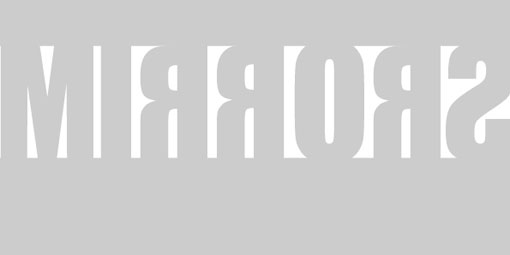
In eleven positions "Mirrors" deals with different facets of mirrors and mirror-like reflections. Starting from its materiality to issues of real spaces and surfaces, the exhibition opens up the view to look at ideas and projections.


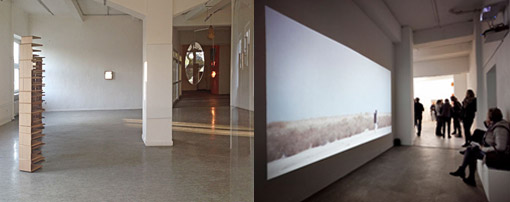
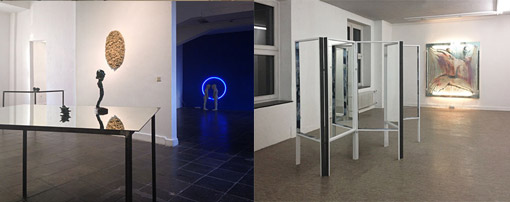
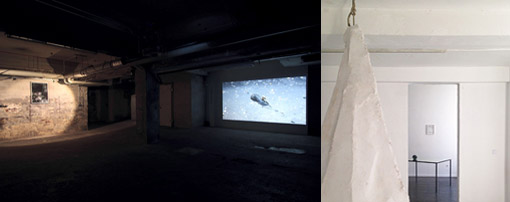
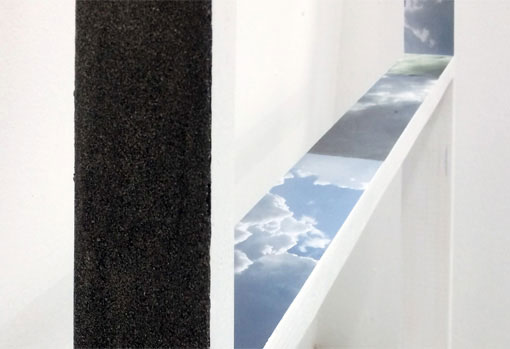
"Outside insight paravent" offers a disorientating, fragmenting view of its surroundings by function of the alternating open frames of the screen and those where the frame is filled with double sided mirror. Alternating lines of asphalt on the outside and lines of sky imagery on the inside of the wooden frames of the screens, direct the viewers eye simultaneously up and down while the view of looking ahead through the open frames and the reflection of the mirror of whats behind presents the viewer with an unsettling experience of multiple dimensions simultaneously.
The piece is an investigation into representing and pin-pointing the psychological state of the in-between. In 1964 the cultural anthropologist Victor Turner described social transitions in life as “social dramas”, which was based on Arnold van Gennep’s model threefold structure: the separation, the liminality (the in-between) and the integration. His thoughts on the state of liminality, as well as the philiospher Gaston Bachelard’s thoughts on the rational versus the irrational mind has accompanied Erlund’s research for several years and function as a strong influence in the conceptual foundation for the entire Outside insight series of works, which Outside insight paravent is part of.
www.sophieerlund.com
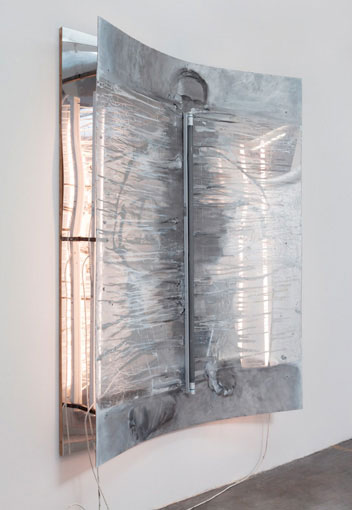
Philipp Fürhofer is a man of the stage: the artist designs scenarios in light boxes that he hangs on the wall like paintings or combines into sculptural groups. Inside acrylic shells he layers painted, translucent substrates and objets trouvés that give rise to mysterious portraits or landscapes whose meaning shifts depending on the intensity of the light.
Fürhofer’s large stage sets—most recently for a production of Verdi’s Les vêpres siciliennes at the Royal Opera in London, for example—are equally seductive. For Die Passagierin at the Badisches Staatstheater in Karlsruhe he created a set illuminated by projections that filtered all of the elements in play. In his Eugen Onegin for De Nederlandse Opera in Amsterdam, he mixed real three-dimensional situations with a kaleidoscopic dream vision of painting, mirrors, and light.
www.philippfuerhofer.de
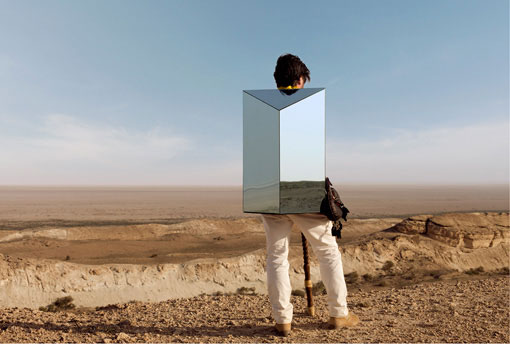
In his film "Walking the Sea", Ginzburg literally and metaphorically crosses the Aral Sea, an inland salt-water sea that lies between Kazakhstan and Uzbekistan. Drawing on the tradition of American Land Art from the late sixties and early seventies, Ginzburg approaches the waterless sea as a ready-made earthwork in order to make visible a territory, history, and a potential imaginary space that remain largely inaccessible. It refers to regional histories and cultural myths, ranging from the figure of the plein-air painter as a traveling dervish to the realist tradition in depicting landscape and the belief in a subterranean “inner sea” into which the Aral Sea has disappeared.
Aral Sea is an inland salt-water sea that lies between Kazakhstan and Uzbekistan. Previously one of the four largest inland bodies of water in the world with an area of more than 26,000 square miles, the Aral Sea has been steadily shrinking since the 1960s and by now has almost dried up. Caused by the Soviet irrigation project, which diverted feeder-rivers to irrigate cotton fields in the surrounding desert, this environmental devastation led to the destruction of the region’s once prosperous fishing industry, unemployment and local climate change.
Calling it a “ready-made earthwork”, Ginzburg explores the poetic paradox of the sea without water. The artist employs landscape that contains the remnants of the twentieth century past to explore themes of collective memory. Carrying a mirror as a device for representation, Ginzburg offers a literal and metaphorical reflection on scenes of historical and natural processes: the exposed seabed, abandoned buildings, military camps, and scattered rusting vessels. The film combines the documentation of the physical experience of crossing the sea with his personal poetic interpretation of a specific place and time.
antonginzburg.com
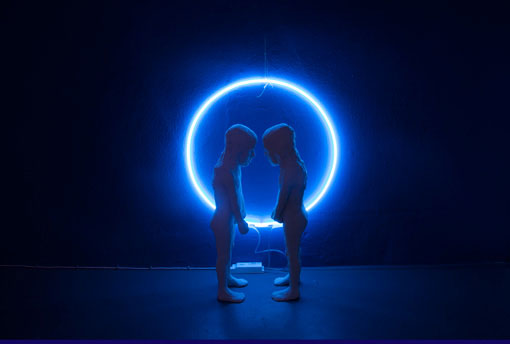
In Heike Kabisch’s sculptures, a mixture of sensuality, power, elegance and others enchanting images of everyday life values, are portrayed on an absurd, cruel and extremely realistic stage. Her sculptures float between attraction and repulsion. Provocative and impudent, the characters’ attitudes spring from a meditative silence waiting for a fearless, proud and heavy expression;
we may meet an elegant minstrel next to a sorrowful little girl, staying together in this tragic-comic atmosphere. Her aesthetically ironic figuration of humans takes the physical body as an allegory of our society; using the self to explore mankind’s manners and paradoxes. Heike Kabisch’s homemade universe looks at our ground and its reality, bringing out the absurd, clumsy, inner beauty of human beings.
heikekabisch.com
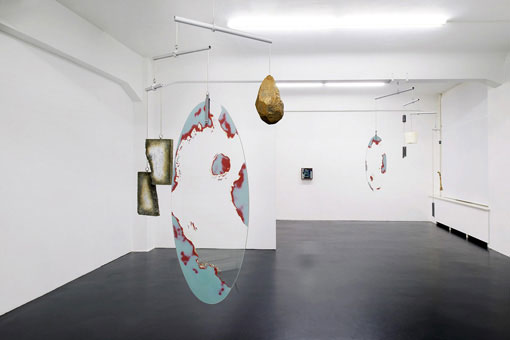
On the end of aluminum poles hanging one large oval mirror, the mirror layer is partially removed. The mirror acts strangely cloudy; semi-reflective, semi-transparent-clear translucent. On the back are the two coats of paint, sanded irregular, which prevents the silver from tarnishing. That makes the levels additionally enigmatic. What you actually see what is where, whether before or after it, whether figure or ground, mirror or transparency - it is difficult to grasp. It's a game of deception, which manufactures and obscured literally the space behind the mirror.
A movement is sufficient to put the mirror in motion to go by each other. As counterweights serve broken paving stones and bronze castings, the half organic and half in the form of crystalline as edgy act hardened drops. Stones, bronze and mirror: The materials contrasting firm and brittle. Together they form a bizarre dance, which rotates on its own tracks and in their own dependencies to himself.
www.gereonkrebber.net
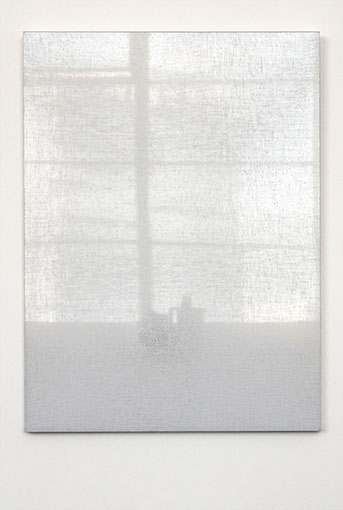
"Untitled White Cloth" balances transparency and opacity. In the mirror, which has been stretched with fabric, the actual space is reflected dimly. This is removed from a clear reflection enough that it could be regarded as an independend image in its own right. The fabric enhances the division between the true and reflected. Nevertheless there remains a depiction of the real space, which moves and changes according to the viewer’s perspective, as well as in relation to the architectural and light conditions. The fabric on the mirror functions as an interface between the pictorial/imaginative and the actual. Space unfolds within the surface.
www.timokube.net

„The Gravitation is our Code. Under these circumstances we are built.“ Sculpture starts under our feet, and extend to our individual horizon, shifting sometimes. Physical powers generate complex forms, as form spontaneous visions of farthest circumstances. Claudia Mann is interested in the origin of sculpture itself and how man is inventor, or referencial point for sculpture. Claudia Mann works under possibilities of human environment, but synchronises conceivability beyond and within our sphere of influence on earth in her works. Space orbit, the earth ́s core are concentrate and also circumstances of sculpture. The cast of the starting point of sculpture is one of her strategies, to widen the defnition of sculpture and to sharpen it. Claudia Mann works in additiv principles and in oberserving circumstances of the materials. Hazard, resistance and interdependency playing fundamental roles. „Sculpture exists through humantity“, Claudia Mann writes. „If first sculpture is the grave? Will sculpture ever exist without humans?“ (Guido Meincke, Art Historian Wilhelm Lembruck Museum Duisburg, 2015)
www.claudiamann.de
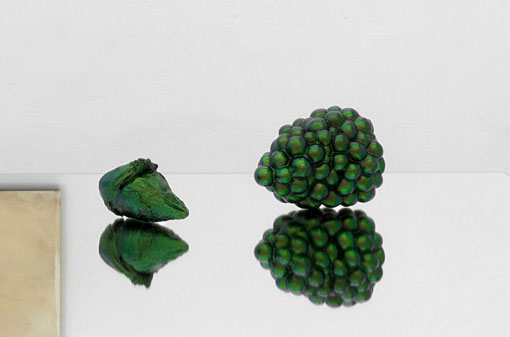
Thomas Musehold’s sculptural work draws on found objects which he uses as a visual aid and turns into sculpture. He analyses and processes these objects; visually through drawings and formally by modifying them by hand or through chemical treatments. For instance, he employs sculptures made of carved wood which often exhibit pastoral or religious motifs and were commonly found in bourgeois sitting rooms of the 1950s. He also works with objects found in nature such as archaic-looking cones or undated glass.
These objects serve as a starting point for further investigation; Musehold begins to chip away at sections, to enter into the material, to shape, to carve and to cut, to form and to cast it. He highlights these newly found forms by finishing the surface in a way that corresponds to the individual object, using commonplace procedures such as shellac polishing or flip flop varnish.
The presentational structures specially developed by Musehold echo the space architecture, adapting to the reflective surfaces of the space as well as relating to the other artpieces. (Excerpt by Arne Reimann for the exhibition Corraxoma, 2015)
www.thomasmusehold.com
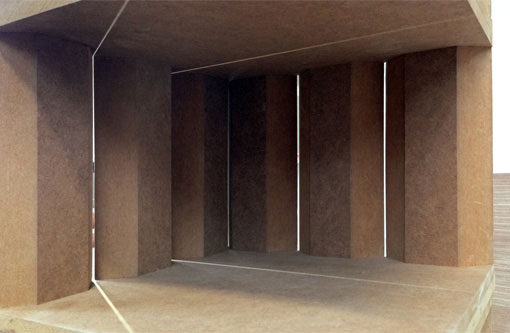
-scape consists of 6 tower modules, which are formally mirrored symmetrically on its axis. The formal reflection is broken by geometric pattern on the base surface of the molds, resulting from the reflection of the light which cut through from the rear side of the work by the column.
While the artpiece has through their formal aspects very static forces, the subtle drawings migrate on the base of the elements with the direction of the light and thus produce changing patterns. These are also, depending on the light, bright, cut strips to very low contrast and blurred lines.
-scape takes reference to urban architecture, whose principal active force is generated by the interplay of materiality as glass and light and through this mirroring of shapes and reflection of their environment and their former self.
The matt MDF stands in contrast to the otherwise clear and shiny surfaces of mirror surfaces and raises questions about quality and characteristics of materiality.
www.aussenwelt.net

The film is constitued by four sequences of twenty minutes. The infinity slide of the drop is realised with a tool which allows the drop to mark time. The performance is related to an animal- documentary-technique. The film is realized on the roof of a water tower. The sound in the film is the direct hearable environment of the shooting.
www.dda-ra.org/fr/oeuvres/Sanchez_Linda
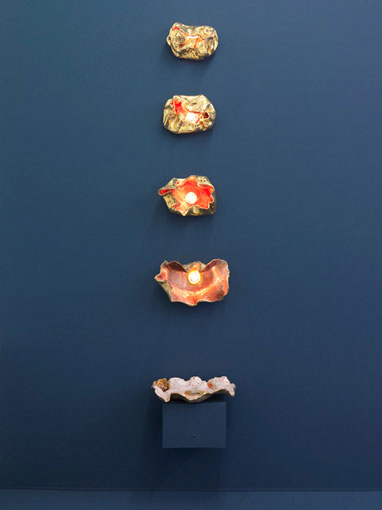
The works of Katja Tönnissen are ironic documents of transitions.
In their shape and color, they seem to accept any final shape and remain defiant on the threshold. This unsteadiness is supported by Tönnissen’s work in series – everything is onward declinable.
With sunsets, the change of light and color within minutes, Tönnissen also concerned with their lamps. She experimented with the transition from pastel shades and the melting of color, already on canvas works. In the ceramic glaze this color transition, the creeping in each other, is especially possible. (Excerpt by Katharina Klang, 2014)
katjatoennissen.de